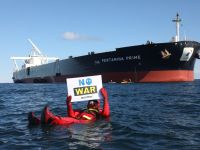The crimea/ukraine crisis is as fundamental a milestone in the international energy market as the US invasion of Iraq or the Nato air war that toppled Colonel Gaddafi’s dictatorship in Libya. President Putin has threatened an “oil war” against the West if Washington and Brussels escalate financial sanctions against the Kremlin. This is a disaster for Germany, which imports more than one-third of its oil and gas from Russia.
European energy companies, notably ENI and British Gas, had built LNG plants in the Egyptian Sinai to hedge their supply risk from Russia. However, the overthrow of the Mubarak regime, protracted street protests, near-civil war in the Sinai and economic distress has made Egyptian LNG exports unavailable for Europe. Egypt’s currency reserve have fallen to only $17 billion, only three months import cover. Egypt owes international gas companies $6 billion and production is threatened by both sabotage as well as General Al Sisi military regime’s inability to reduce fuel subsidies or electricity consumption. Cairo, Alexandria and even the Nile Delta/Suez port cities suffer periodic blackouts. Foreign oil and gas companies have threatened to exit Egypt if the government does not pay their dues. In fact, the Ukraine crisis has increased Cairo’s sovereign financial crisis since Egypt is the world’s largest importer of wheat, whose price is heavily subsidised. Despite the EU’s investments in the Sinai natural gas plants or pipeline network, Egypt cannot be a credible natural gas exporter to Europe.
Qatar, the leading natural gas producer in the Arab world, can supply natural gas to countries like Turkey, Italy, Poland and Hungary, where dependency on Russian gas imports is now perceived as a threat to national security. For instance, Poland has purchased Qatari LNG since 2006, when the Kremlin first cut off gas supplies to Ukraine after a pricing dispute. The Baltic States are also investing in LNG import infrastructure could also be natural export markets for Qatargas.
Qatar is an LNG superpower despite its miniscule population. Qatar owns the world’s second-largest gas reserves after Russia. Qatari gas reserves are more than half of Russian gas reserves, making it a rival to the Kremlin and Gazprom in European and Far East gas markets.
Qatar’s entire energy complex was designed to export LNG via tankers to China, Japan, Taiwan, Singapore and South Korea and India. Qatari gas is 30 per cent more expensive than Russian gas for German, Polish and Central European utilities. The global LNG market is dependent on long-term government contracts where politics is more important than commercial considerations. If the German Chancellor or the Polish Prime Minister decide Qatari LNG imports is a political priority to reduce reliance on Gazprom, the governments in Warsaw, Berlin and Doha will adjust contract prices to suit geopolitical goals. However, economic crisis in Greece, Spain, Italy and Turkey could limit government appetite for expensive Qatari LNG imports.
One long-term consequence of the new East-West confrontation in Ukraine means greater energy cooperation between Russia and China. The Chinese have signed multi-billion dollar oil and gas supply deals with Rosneft and Gazprom since the Chinese will replace the US as the world’s leading oil and gas importer in 2014. China is to reduce its dependence on geopolitically risky oil imports from Iran, Sudan and Egypt.
The influx of Qatari LNG in Europe will anger the Kremlin. How will Russia retaliate against Qatar if Qatar LNG undermines Gazprom’s market share in Western Europe? Crimea’s annexation has isolated Russia in Europe while Putin’s military/diplomatic support for Syria and Iran have alienated leading Arab states in the Middle East. This will threaten Russia’s international trading linkages in the world’s most vibrant economies. Arab LNG, Norwegian LNG and Nigerian LNG will increase market share Europe. Renewable energy will also benefit from the Ukraine crisis in the long run.
By: Sarie Khaled
The writer is a Dubai-based research analyst in energy and GCC economics.








